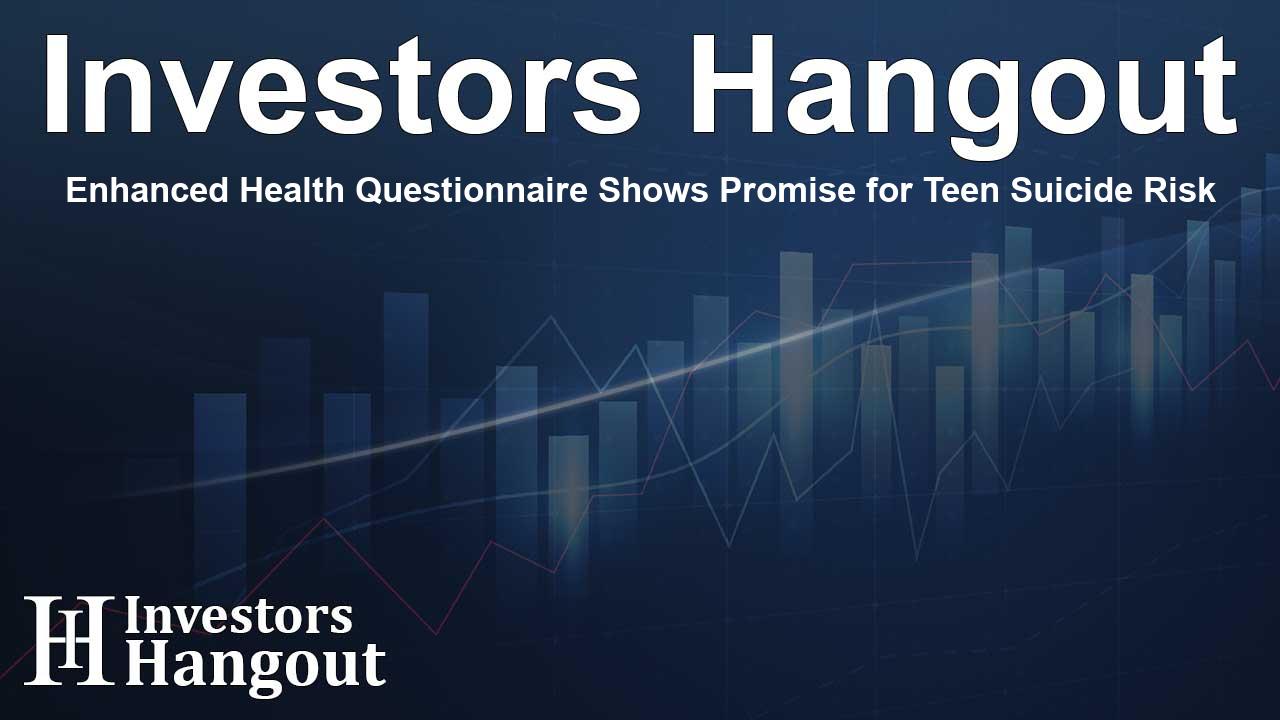Enhanced Health Questionnaire Shows Promise for Teen Suicide Risk

Researchers Develop Enhanced Suicide Risk Assessment for Teens
Adolescent mental health is critical to the well-being of our future generations. Recent research conducted by the Children's Hospital of Philadelphia (CHOP) and the University of Pittsburgh has unveiled a modified health questionnaire that demonstrates a higher capability in predicting suicidal behavior among teens, compared to traditional methods.
Significance of Suicide Prevention
Suicide has unfortunately become one of the leading causes of death in adolescents, presenting an urgent need for effective screening methods. Pediatricians now routinely incorporate screening for depression and suicidal ideation in healthcare checkups for young patients. The goal is clear: to proactively identify and assist those at risk.
The PHQ-9 and Its Limitations
Traditionally, the Patient Health Questionnaire–9 (PHQ-9) is employed as a self-report screening tool for depression among both adults and adolescents. It includes a crucial question—Item 9—that gauges current suicidal thoughts or self-harm tendencies. While PHQ-9 is effective, studies show that over one-third of adolescents who attempted suicide or experienced fatal outcomes did not report any suicidal thoughts at the time of screening. This gap highlights the need for improved assessment tools.
The Modified Questionnaire (PHQ-9M)
To address these limitations, the World Health Organization has introduced a modified version of the PHQ-9 specifically tailored for teens, known as the PHQ-9M. This new questionnaire retains the nine essential questions of the original PHQ-9 while adding four supplementary questions. These new items assess factors such as recent depressive symptoms, functional impairment, serious suicidal thoughts over the past month, and any history of suicide attempts.
Research Findings on the PHQ-9M
A study involving 130,028 outpatients who completed a total of 272,402 PHQ-9M screenings highlighted the efficacy of this new instrument. Among these participants, 549 patients, representing 0.4%, subsequently attempted suicide within a year of their screening results. The analysis revealed that the PHQ-9M significantly outperformed the traditional PHQ-9 in predicting suicidal behaviors.
Key Predictive Elements of the PHQ-9M
In particular, the strongest predictors of suicidal behavior identified through the PHQ-9M included questions pertaining to lifetime suicide attempts, severity of mood-related symptoms over the past year, and serious suicidal ideation experienced within the previous month. These findings substantiate the need for continued innovation in mental health screening.
Advancing Early Detection and Intervention
Senior study author David Brent, MD, emphasizes that merely screening for depression is inadequate in predicting suicide risk. He indicates that including factors such as a patient’s previous suicidal behavior and current mental state can vastly enhance prediction accuracy, thus potentially saving lives.
Fuchiang (Rich) Tsui, PhD, a primary author of the study, advocates for integrating the results of the PHQ-9M with electronic health records. This progressive approach could enhance predictive modeling, allowing for timely and personalized intervention strategies tailored to the individual needs of at-risk teens.
Looking Ahead
The study reinforces the importance of ongoing efforts to refine screening processes in pediatric health care to better prevent suicide among adolescents. As mental health challenges become increasingly apparent, recognizing the nuances of each patient’s psychological well-being is essential for effective treatment and prevention.
Conclusion
With increased awareness and innovative tools like the PHQ-9M, the healthcare community is now better equipped to tackle the pressing issue of adolescent suicide, paving the way for brighter futures.
Frequently Asked Questions
What does the PHQ-9M questionnaire consist of?
The PHQ-9M includes nine core items from the PHQ-9, plus four additional questions focused on depression in the past year, functional impairment, serious suicidal ideation in the past month, and history of suicide attempts.
Why is early detection of suicidal behavior vital?
Early detection allows for timely interventions, which can significantly reduce the risk of suicide attempts among adolescents.
How can healthcare professionals use the PHQ-9M?
Healthcare professionals can utilize the PHQ-9M as part of routine screenings to better assess and identify adolescents at risk for suicide.
What role does electronic health records play in suicide prevention?
Integrating questionnaire results with electronic health records can enhance predictive modeling, allowing for more personalized care strategies for at-risk youth.
Are there any support programs for at-risk adolescents?
Yes, various mental health support programs are available that focus on providing resources and counseling for adolescents exhibiting signs of distress and suicidal thoughts.
About Investors Hangout
Investors Hangout is a leading online stock forum for financial discussion and learning, offering a wide range of free tools and resources. It draws in traders of all levels, who exchange market knowledge, investigate trading tactics, and keep an eye on industry developments in real time. Featuring financial articles, stock message boards, quotes, charts, company profiles, and live news updates. Through cooperative learning and a wealth of informational resources, it helps users from novices creating their first portfolios to experts honing their techniques. Join Investors Hangout today: https://investorshangout.com/
Disclaimer: The content of this article is solely for general informational purposes only; it does not represent legal, financial, or investment advice. Investors Hangout does not offer financial advice; the author is not a licensed financial advisor. Consult a qualified advisor before making any financial or investment decisions based on this article. The author's interpretation of publicly available data shapes the opinions presented here; as a result, they should not be taken as advice to purchase, sell, or hold any securities mentioned or any other investments. The author does not guarantee the accuracy, completeness, or timeliness of any material, providing it "as is." Information and market conditions may change; past performance is not indicative of future outcomes. If any of the material offered here is inaccurate, please contact us for corrections.








